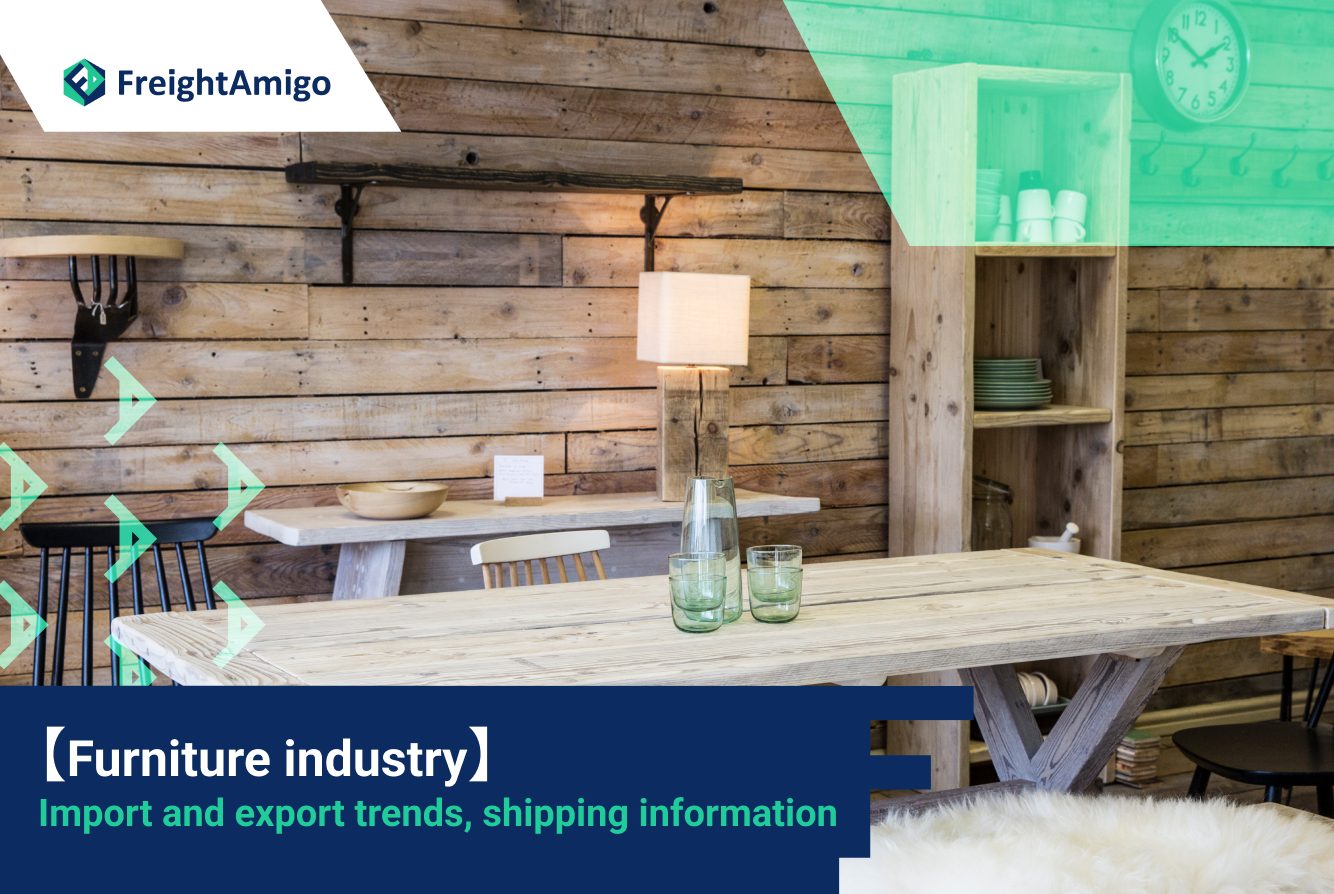In recent years, more and more people are choosing to purchase furniture online. In Japan, imported furniture is mainly sold in specialty stores and department stores, but online sales are also becoming more popular. In these mature markets, more and more retailers and wholesalers are purchasing furniture directly from manufacturers, but some still purchase goods through agents and distributors. In mainland China, furniture districts and furniture malls are very popular at both the retail and wholesale levels. With the continuous development of e-commerce in China, more and more furniture brands and retailers are adopting an omni-channel business model, allowing consumers to touch the products in-store before purchasing online and enjoying home delivery services. Many Hong Kong manufacturers produce furniture products for foreign major brands through original equipment manufacturing (OEM) or original design manufacturing (ODM).
Author Name:Tiffany Lee – Marketing Analyst at FreightAmigo
Want To Compare The Best Express, Air Freight, Sea Freight, Rail Freight & Trucking Rates So As To Have Better Control On Cost?
Furniture Industry Import and Export Information
In recent years, online shopping has become popular, with many foreign e-commerce platforms offering low prices and a wide selection, attracting cross-border online shopping by Taiwanese consumers. However, buying wooden furniture requires attention! The Keelung Customs of the Ministry of Finance issued a special announcement yesterday (31st) stating that if people purchase “unprocessed solid wood furniture or plant products such as wooden block decoration, seeds, and plants” through cross-border online shopping, they could be fined up to NT$150,000, and the imported goods may also be confiscated. Consumers are advised to be careful when shopping online to avoid both losing money and breaking the law.
Some online shopping platforms do not provide detailed product descriptions, which can easily lead to people purchasing quarantined items through cross-border e-commerce. Therefore, it is recommended that consumers confirm with the manufacturer whether their raw materials and processing methods comply with regulations before purchasing and also pay attention to whether the product is a Chinese item that is not allowed to be imported into Taiwan to avoid breaking the law. Keelung Customs reminds people that recently, people have been ordering home furnishings, seeds, and plants, and other plant products through e-commerce platforms and importing them by sea, but these goods are subject to import regulations such as quarantine. Keelung Customs has also repeatedly caught similar violations. Therefore, people are advised to be cautious to avoid breaking the law.
Furniture Industry CEPA
The “Mainland and Hong Kong Closer Economic Partnership Arrangement” (CEPA) was signed in June 2003 and supplemented every year thereafter. Products manufactured in Hong Kong that meet the CEPA rules of origin can be imported into the Mainland at zero tariff.
Under the CEPA framework, the Mainland and Hong Kong signed the “Goods Trade Agreement” in December 2018, which optimized the rules of origin arrangement. Since January 1, 2019, goods originating from Hong Kong will enjoy zero tariff concessions when imported into the Mainland. In addition to the “product-specific rules of origin,” a general rule of origin based on the value-added in Hong Kong is introduced, allowing products without “product-specific rules of origin” to be imported into the Mainland at zero tariff, as long as they comply with the “general rule of origin.”
In general, the CEPA rules of origin applicable to Hong Kong products include: (1) changes in tariff classification; (2) specific manufacturing or processing procedures performed in Hong Kong; or (3) meeting the regional value content standard, which calculates the percentage of raw materials, components, labor costs, and product development costs in Hong Kong, which account for at least 30% of the product’s FOB price through a cumulative calculation method or a non-originating material deduction method of no more than 60%.
Furniture Industry Logistics Considerations
Import:
To prevent the entry of the Asian longhorned beetle, the United States and Canada have implemented additional control measures on imported solid wood packaging materials from Hong Kong and China. Goods with solid wood packaging materials must be heated, fumigated, or treated with preservatives before shipment, or they will be prohibited from entering. Controlled shipping goods include:
- Goods from Hong Kong to the United States or Canada with solid wood packaging materials attached;
- Goods from China to the United States or Canada via Hong Kong with solid wood packaging materials attached and solid wood packaging materials added during repackaging in Hong Kong;
- Goods from China to the United States, Canada, or the United Kingdom with solid wood packaging materials attached.
- Controlled solid wood materials include wood used for packaging boxes, crates, barrels, pallets, skids, pads, and racks that retain their natural round surface. Synthetic or highly processed wood packaging materials (such as veneer plywood, oriented strandboard, corrugated paperboard, plastics, and resin mixtures) are not subject to the above regulations.
Export:
Hong Kong goods exported to the United States and Canada with solid wood packaging require the same customs clearance procedures. Manufacturers need to carry out pest control procedures with designated fumigation companies before going to the Hong Kong Agriculture, Fisheries, and Conservation Department for “verification and stamping.” As for goods originating from China and exported to the above regions, they must be accompanied by a valid certificate issued by the Chinese mainland’s Entry-Exit Inspection and Quarantine Bureau.
In addition, the control of goods exported to the UK is more relaxed. Solid wood packaging materials from China only need to have their bark and insect holes removed or be heated, and do not require a phytosanitary certificate or other form of documentation. However, if the terms and conditions are not followed, the UK authorities may require the destruction of infected materials, etc.
The procedures for verifying and stamping fumigation and disinfection certificates by the Hong Kong Agriculture, Fisheries, and Conservation Department are as follows:
- The fumigation company, cargo owner,or freight forwarder should submit the fumigation certificate and relevant documents to the department for verification and stamping.
- The department will check the documents and inspect the cargo to ensure that it meets the requirements
- If the cargo passes the inspection, the department will stamp the fumigation certificate to indicate that the cargo has been treated and is eligible for export.
- The stamped fumigation certificate and relevant documents should be presented to the customs authorities for clearance. ” The fumigation service provider issuing this certificate holds a valid permit issued by the Director of Agriculture and Fisheries to use methyl bromide for quarantine and pre-shipment fumigation as at the date of this certificate.”
It is important for furniture industry businesses to comply with these regulations to avoid delays or rejection of their shipments and ensure smooth logistics operations.
FreightAmigo’s Services for the Furniture Industry:
- Fumigation treatment services for furniture
- Visible and controllable logistics managemen
- One-stop value-added services to simplify the process
- Your 24×7 personal logistics expert
- Automated status updates
- Customized logistics solutions
There Are Different Options For Cargo Transportation. If You Want To Choose The Most Convenient And Suitable Solution, It Is Best To Have The Full Support Of Logistics Experts! If You Are Planning To Ship Goods Overseas, Please Go To The FreightAmigo Page For Inquiries.
read more:
【Electronics Industry】Import and Export Data, Logistics Restrictions
【Entrepreneur’s Guide】Important Information for Applying for Technology Voucher Programme
【Logistic 101】Shipping guideline for wine industry
===
If you have any inquiries on logistics/supply chain, feel free to contact FreightAmigo now:
Chat with us online OR
Phone : +852 28121686
WhatsApp: +852 27467829



